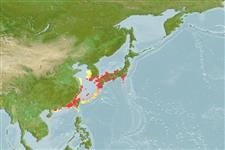Environment: milieu / climate zone / depth range / distribution range
Ecologia
marino associati a barriera corallina; distribuzione batimetrica 0 - 30 m (Ref. 89707). Tropical; 37°N - 20°N, 112°E - 143°E (Ref. 5222)
Northwest Pacific: southern Japan, Korea, Taiwan, and China. Reports of the species (under the valid name or as Epinephelus fario) from the Indian Ocean are apparently based on misidentifications.
Length at first maturity / Size / Peso / Age
Maturity: Lm ?, range 29 - ? cm
Max length : 50.0 cm TL maschio/sesso non determinato; (Ref. 89707)
Spine dorsali (totale): 11; Raggi dorsali molli (totale): 16-17; Spine anali 3; Raggi anali molli: 8. Preopercle rounded; serrae mostly hidden by skin; upper edge of operculum straight; nostrils small, subequal; maxilla reaches to or beyond vertical at rear edge of the eye. Area behind pectoral-fin tip with a patch of ctenoid scales in juveniles. Color is pale brown with small red or reddish brown spots. Fins darker, also covered with spots and often with a narrow white edge. A black blotch is at the base of the last 3 dorsal-fin spines, a smaller blotch at the base of the middle dorsal-fin rays, and a third on top of the caudal peduncle. Distinguished further by the following characteristics: body depth contained 2.7-3.3 times in SL; head length 2.4-2.6 times in SL; slightly convex interorbital area; small anterior and posterior nostrils, subequal; maxilla reaches to or past vertical at rear edge of eye; 2 rows of teeth on midlateral part of lower jaw (Ref. 89707).
Juveniles are common in tide pools and in shallow clear water around rocks and coral reefs; adults found in deeper water. Kuo et al. (1988, Ref. 6826) induced sex reversal and artificial spawning (referred to as 'Epinephelus fario').
Life cycle and mating behavior
Maturità | Riproduzione | Deposizione | Uova | Fecundity | Larve
Heemstra, P.C. and J.E. Randall, 1993. FAO Species Catalogue. Vol. 16. Groupers of the world (family Serranidae, subfamily Epinephelinae). An annotated and illustrated catalogue of the grouper, rockcod, hind, coral grouper and lyretail species known to date. Rome: FAO. FAO Fish. Synop. 125(16):382 p. (Ref. 5222)
IUCN Red List Status (Ref. 130435)
Threat to humans
Harmless
Human uses
Warning: mysqli::__construct(): (HY000/1040): Too many connections in /var/www/html/includes/func_getlabel.php on line 46
Can't connect to MySQL database (fbapp). Errorcode: Too many connections
